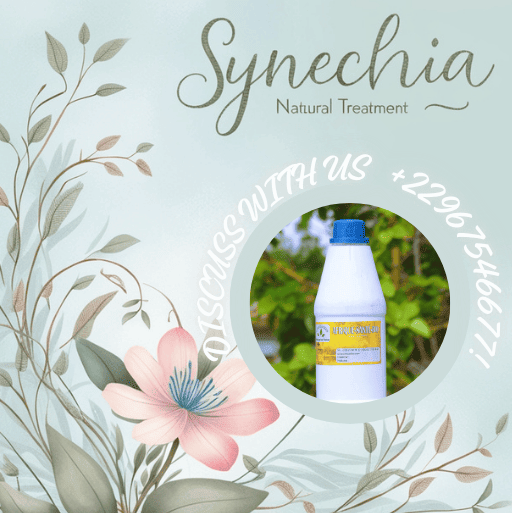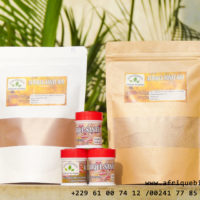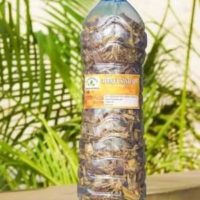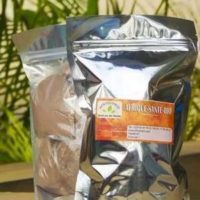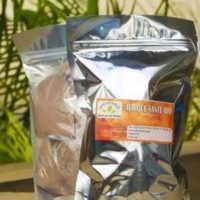Description
d Synechia Natural Treatment. Undergo our herbal tea designed to purify and cleanse the uterus, while also promoting conception for women of childbearing age.
Synechia Natural Treatment
Technical Sheet for Synechia Natural Treatment
Presentation of Herbal Tea 780: Synechia Natural Treatment
— Powder in a transparent sachet.
— Weight: 50g
Composition of Natural Treatment for Uterine Synechia
Plant extract.
Active Ingredients of Synechia Natural Treatment
— Astringent and absorbent tannins, anti-inflammatory and antifibrinolytic heterosides, etc.
Price: €50
Indications of the herbal tea to treat uterine synechia
Uterine synechia, Uterine synechia, female sterility, early menopause.
Side Effects of the Natural Plant to Treat Uterine Synechia
– None
Instructions for the Natural Treatment of Uterine Synechia
To prepare the solution, bring one litre of water to a boil and add one tablespoon of the powder. Allow it to boil for five minutes, then let it cool and strain the mixture. Consume half a glass of the prepared solution twice daily for three months, with the option to renew the regimen.
NB: Do an ultrasound in the middle of treatment to assess the detachment of the uterine wall. Allow 3 months of treatment with 12 sachets.
Benefit Effect of Synechia Natural Treatment
Herbal Tea 380: Synechia Natural Treatment is formulated from a selection of rare and highly effective medicinal plants specifically targeting various forms of uterine synechia. This natural remedy effectively eliminates synechia, enabling women to conceive and maintain a healthy pregnancy.
In conjunction with Herbal Teas 264 and 270, it promotes the separation of uterine walls, followed by a healing process. This herbal infusion serves to purify and cleanse the uterus, addressing uterine synechia and enhancing fertility in women of reproductive age.
Read more about endometriosis risk during pregnancy
Symptoms of uterine synechia
Most patients do not experience any symptoms. Its symptoms are often discovered incidentally during a diagnostic hysteroscopy or hysterosalpingography. They are sometimes found during an infertility assessment and more rarely in the face of suggestive clinical signs:
Secondary amenorrhea
(absence of periods) or oligomenorrhea (light periods), occurs following curettage or uterine aspiration. These signs are often accompanied by cyclical pelvic pain, explained by the difficulty in evacuating the blood present in the uterus at the time of menstruation. The diagnosis of synechia is suggested in this context after eliminating that of a new pregnancy, a miscarriage or an ectopic pregnancy by a pregnancy test and a pelvic ultrasound.
Read more about Pelvic Congestion Natural Treatment
Infertility:
Synechiae in the uterine cavity can hinder the sperm from reaching the egg or the embryo’s implantation.
Recurrent early miscarriages:
The presence of synechiae sometimes causes the expulsion of the embryo because the uterine cavity is small with poor-quality endometrium, thus preventing embryonic development.
Placental pathologies:
placenta previae, placenta accreta.
MAKE AN APPOINTMENT WITH LADY RACHI HERE
Causes of Uterine Synechia
A synechia or adhesion often occurs in the uterus after a uterine curettage. Indeed, it occurs during a poor healing process during which the two walls remain together while healing an internal injury in the uterus. It is then made up of a simple mucous band, easily lifted by the passage of the hysteroscopy during a diagnostic hysteroscopy. Without treatment, this loose band becomes fibrous, resistant, thick, and muscular, removing its endometrium cover.
The following circumstances can cause the formation of a synechia:
- Curettage or aspiration for early miscarriage or voluntary termination of pregnancy, post-abortive or postpartum curettage.
- Retention of an arrested pregnancy, placental retention after childbirth or after termination of pregnancy.
- Operative hysteroscopy with fibroid resection, polyp resection, uterine malformation cure, endometrialectomy, aspiration during cervical dilation.
- Myomectomy, colonization.
- Significant endometrial atrophy due to hormonal deficiency linked to menopause.
- Uterine infection, endometritis, genital tuberculosis, infection on IUD.Post-pelvic radiotherapy for cancer.
Other Factors
Certain factors promote the occurrence of uterine synechiae following trauma to the endometrium:
- Softened uterus: this is the case during an advanced pregnancy; retention of a dead egg; and postpartum (after childbirth).
- Uterine evacuation technique with an increased risk respectively when using a suction cannula, a blunt curette or a fenestrated curette.
- The occurrence of an infection following uterine evacuation.
- The presence of two traumatized areas at the endometrium, opposite each other, promotes healing through a « fibrous bridge » through direct contact
Click here to discuss with a specialist
Plants and natural remedies to treat uterine synechia
Yarrow
It is a decongestant plant of the uterus that helps reduce menstrual cramps. And also promotes blood circulation and helps regulate blood flow. It has an antispasmodic action and helps relieve pain and inflammation.
Yarrow can therefore be effective in cases of painful and heavy periods. It can be consumed as an herbal tea.
Green tea: Natural Remedy for Uterine Synechia
Green tea, an antioxidant, reduces oxidative stress, fights free radicals, and reduces endometrial cell proliferation and endometriosis lesions. It also regulates estrogen receptor overproduction.
Turmeric
Curcumin, an active ingredient in turmeric, has been found to reduce endometrial proliferation and pain associated with endometriosis due to its anti-inflammatory and antioxidant properties.
Plain Yogurt To Naturally Treat Uterine Synechia
Plain yoghurt is a natural remedy for vaginal infections due to its high lactobacilli content. Drinking at least half a glass daily is recommended, but consult a doctor if experiencing reactions or intolerance.
Garlic
It is the most powerful natural antibiotic. Its active compounds contain antibacterial properties, although there is no evidence that its consumption eliminates this problem. However, you can try to include it in your menus:
Ingredients:
1 clove of garlic
1 glass of water (200 ml)
Preparation:
– Crush the raw garlic clove and add a glass of hot water.
– Let it sit for 10 minutes and drink the infusion.
Milk and turmeric: Natural Remedy for Uterine Synechia
It is believed that a combination of milk and turmeric would be a simple antibacterial remedy (due to the antibacterial properties of turmeric) that would kill yeast and protect the vaginal area.
However, there is not enough evidence to support the safety of these claims; if you decide to take it, first check that you are not allergic to any of the ingredients.
Ingredients:
1 teaspoon of turmeric powder (5g)
Preparation:
Heat the glass of milk, then add the teaspoon of turmeric powder.
Serve warm and repeat daily until discharge is relieved.
Natural Remedy for Uterine Synechia
Taste once a day for a week.
READ MORE
Aloe vera: Synechia Natural Treatment
The aloe vera plant has many moisturizing benefits. In the same way that it activates its properties at the skin level, aloe vera acts gently in the vaginal ecosystem, keeping it hydrated.
It is also used externally by spreading the pulp on the areas of the vulva that itch, burn or are dry. It is also a natural lubricant that does not alter our pH. Internally, it is used as an ovule to refresh, reduce inflammation and heal wounds caused by a vaginal infection.
- Preparation:
- Soak the stem in water for a minute to remove iodine and earth.
- Cut the thorns and peel the stem on both sides.
- Remove the transparent pulp, roll it into an ovule and carefully insert it into the vaginal canal.
Application:
Use in the evening for three nights in a row, the body heat will absorb the pulp into the vaginal mucosa.
Recommendation:
Natural Remedy for Uterine Synechia
Before using fleshy stems, ensure there are no allergic reactions by testing the pulp beforehand.
